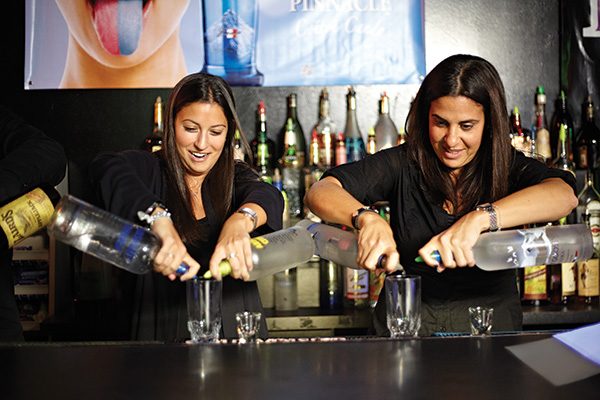
Mixology is more complicated than it might appear from a freshly made mojito. There’s the equipment: short and tall shakers, spring and julep strainers, the jigger, the muddler and the bar spoon. There’s the glassware: the single, the double, the snifter, the Collins, the highball and the hurricane, to name a few. There’s the garnish: lime or lemon wedge, wheel or twist; the flag (cherry, orange or pineapple on a stick); and of course, the olive. And let’s not forget the alcohol: vodka, gin, tequila, rum and the rest. The possibilities are endless.
On a recent Saturday night, I joined a Quick Mixx class at Mix ‘Em Up Bartending School in Verona to try my hand at this art. The class is suitable for would-be professional bartenders, ambitious home entertainers and those who just want to have a few hours of fun while picking up some new skills. “It’s stepping your toes in the water,” said director Joanne Lisa, an experienced bartender and bar owner who has been teaching for five years.
My only previous bartending experience had been the occasional rum and coke I mixed in my college dorm room. But during the class, I quickly learned that the art of making and serving a drink calls for more than a bottle of booze and a splash of soda. It requires knowledge and rhythm—not to mention strong wrists.
For starters, my fellow students and I had to master the free pour. This entails pouring four counts of alcohol from a standard spout to produce one perfect ounce. We tried it with our right hands, our left hands, then both hands at the same time. Lisa made it look easy, but it’s not.
Next came the basic rules. Scoop ice with the metal shaker—a glass might break. If someone asks for soda, it’s automatically club soda. Flavored martinis are shaken (James Bond was right!), but Rob Roys and Manhattans are stirred. A drink with ice gets a straw, which has to be the right size. For example, a Collins gets a longer straw than a highball. “A big glass gets a big straw,” Lisa instructed. “That’s common sense.” There are also rules for when a garnish should match or contrast the color of the drink.
Knowing the jargon is essential, too. Neat means not chilled, so no ice, no straw. Make it up means put the drink in a martini glass. Then there are matters of style. A martini should always be poured with a bit of traveling room at the top to prevent spills, and a bartender should never hold a glass by the rim.
After the briefing, my classmates and I broke into small groups. We practiced ordering and crafting drinks from the simple screwdriver to the tedious bloody Mary (Lisa’s features vodka, tomato juice, Tabasco sauce, Worcestershire sauce, horseradish, celery salt, pepper and a celery stick). Three or four drinks into my turn behind the bar, I realized I had been getting my ice from the dump sink, not the jockey bin, where the serving ice is stored. I couldn’t seem to nail down my straw selection, and garnishes were beyond my comprehension.
Lisa taught us one Garden State-inspired drink, the aptly named New Jersey Turnpike, which amounts to a shot of all the night’s leftovers from the bar’s spill mat. “If you’re willing to drink that,” said Lisa, “something’s wrong.”
For now, I think I’ll stick to wine and beer.
